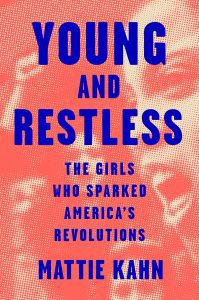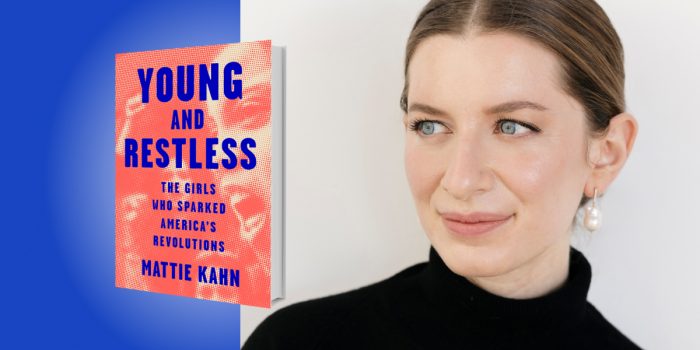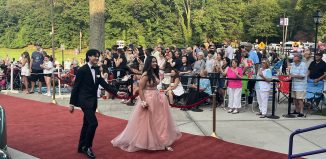Between You and Me: ‘Crusader in a mini-skirt’ and other such Girl Revolutionaries
By Leah S. Dunaief

A book whose subject caught my eye this week is, “Young and Restless, The Girls Who Sparked America’s Revolutions,” by Mattie Kahn. The story appeared in the New York Times Book Review this past weekend, and I read of these female exploits, marveling at the young ages of the subjects.They were indeed girls, most in their teens or younger, not yet women by today’s standards. Now my mother, who was born in 1906, was only 11 when she began her work life, a graduate of 8th grade with a further degree from a bookkeeping school. While I have long been amazed at that, these stories begin with the Lowell mills girls in 1836 and Harriet Hanson, 11, who led a “turn-out” of 1500 young women refusing to work.
I was not familiar with the Lowell mills history. It seems Francis Cabot Lowell was impressed by the textile factories he saw in England and returned to Massachusetts to build similar workplaces and participate in the Industrial Revolution. For the most part, the workers were girls and young women. The early mills were a kind of “philanthropic manufacturing college,” to which such luminaries as Ralph Waldo Emerson and Edgar Allan Poe came to lecture. These were the first places where girls, who were not the daughters of rich men, and hence not at finishing schools, could gather and learn as they worked. It was here, at a factory in Lowell, Massachusetts, where the first all-female-staffed magazine in American history was started.
When the girls were informed that their pay was to be cut, they went on strike. Hanson organized the walkout with what she later called “childish bravado.”
 The book tells stories of many more such young women—girls really—protesting in different circumstances. “There’s Mabel Ping-Hua Lee, who led 17,000 people up New York City’s Fifth Avenue on horseback in the 1912 march for women’s suffrage.” Anna Elizabeth Dickenson was an abolitionist orator in her teens and became the first woman to address the House of Representatives. Heather Tobis (Booth) at 19, “founded the legendary abortion referral service Jane out of her dorm room. Clyde Marie Perry, 17, and Emma Jean Wilson, 14, integrated their Granada, Mississippi schools in 1966 and then successfully sued to stop expulsions of pregnant students like themselves.”
The book tells stories of many more such young women—girls really—protesting in different circumstances. “There’s Mabel Ping-Hua Lee, who led 17,000 people up New York City’s Fifth Avenue on horseback in the 1912 march for women’s suffrage.” Anna Elizabeth Dickenson was an abolitionist orator in her teens and became the first woman to address the House of Representatives. Heather Tobis (Booth) at 19, “founded the legendary abortion referral service Jane out of her dorm room. Clyde Marie Perry, 17, and Emma Jean Wilson, 14, integrated their Granada, Mississippi schools in 1966 and then successfully sued to stop expulsions of pregnant students like themselves.”
Perhaps the girl who interested me most because she overlapped with my life was Alice de Rivera, dubbed by the New York City media as the “crusader in mini-skirts.” She was 13, had scored on a citywide test in the 99th percentile in math, but was denied the right to take the entrance exam to Stuyvesant High School in 1969 because she was female. She and her parents, Joseph, a psychology professor, and Margaret, an educational therapist, lived in Brooklyn at the time, and the high school she was supposed to attend did not have appropriate classes for her further education. Stuyvesant, one of the best high schools in New York City, did.
Now I am familiar with Stuyvesant. I went to the all-girls Hunter College High School in the 1950s, and we would periodically have “socials” with the Stuyvesant boys. They were more like milk-and-cookie gatherings, but nonetheless at one of them I was asked out on my first date.
Alice de Rivera met with the National Emergency Civil Liberties Committee, where she was introduced to Eleanor Jackson Piel, who took her case pro bono. Fighting educational sexual segregation was a radical idea at the time. Most specialized schools and even the Ivies were all-male. But on the grounds that it violated Alice’s 14th Amendment of equal protection, they filed a lawsuit on January 20, 1969 against the state’s Board of Education. She received a lot of publicity, and by May, the Board voluntarily repealed Stuyvesant’s sex restriction. It was a cultural precedent that broke barriers.
What happened to De Rivera? She and her family moved out of New York City, so she didn’t go to Stuyvesant. Today she is a physician, living on a farm in Maine with her husband, a retired math professor, and working at a clinic she started, helping Lewiston’s large population of Somali refugees. She also works at another facility that serves people who can’t pay for their medical care.







